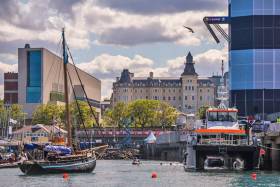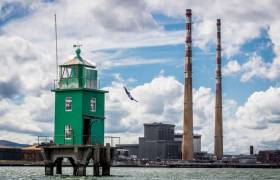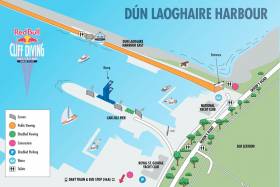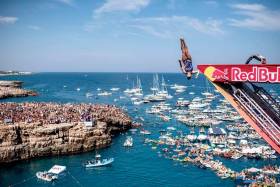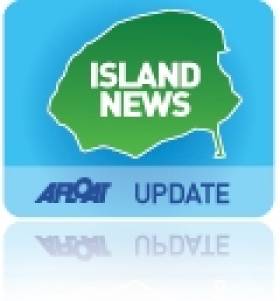Displaying items by tag: Red Bull Cliff Diving World Series
Red Bull Cliff Diving World Series Set to Make First Stop in Northern Ireland on Causeway Coast
For the first time ever, this summer Northern Ireland’s Causeway Coast will welcome the Red Bull Cliff Diving World Series.
Positioned in the World Series calendar as a major mid-season shake-up, the fourth stop of 2024 from 18-20 July has multiple take-off spots lined up throughout the event — a challenge that will surely test the divers to their limits.
In the opening rounds, dives will launch directly off the cliffs at both Kinbane Castle and from the iconic cove known as ‘Lord’s Prayer’. The competitors will then wrap up the final two rounds by diving from the purpose-built platforms constructed in Ballycastle Harbour.
Though the Causeway Coast is a first for 2024’s diver line-up, the World Series has previously hosted five stops “down the road” on the island of Ireland, most recently in 2021 — 180 miles from Ballycastle at Downpatrick Head, Co Mayo where the divers plunged into the rough waters of the Atlantic Ocean.
With coastal conditions prone to throwing challenging conditions into the mix at any given time, expect the mid-season stop to serve up plenty of twists and turns and dramatic battles, as the divers fight for cliff-diving supremacy.
For more details, see the Red Bull website HERE.
Red Bull’s official media partners have shared some specular footage of the action from this past weekend’s Cliff Diving World Series stop in Dun Laoghaire Harbour.
Crowds numbering some 145,000 were in attendance over Saturday 11 and Sunday 12 May, amounting to the highest ever spectator turnout in the event’s 10-year history.
And they were thrilled by a dazzling performance by reigning women’s champion Rhiannan Iffland as she continued her dominance.
Meanwhile, in the men’s division, Romania’s Constantin Popovici scored victory in only his second event, after placing second in his debut at April’s opening leg in the Philippines.
The Red Bull Cliff Diving World Series makes its long-awaited debut in Dublin this afternoon (Saturday 11) with events kicking off at Dun Laoghaire’s Carlisle Pier at 5pm.
As previously reported on Afloat.ie, entry is now free for the two-day competition but organisers have advised everyone attending to arrive early to ensure a spot to witness the action.
Big numbers will be expected at the waterfront to see reigning champions Gary Hunt and Rhiannan Iffland continue their domination of the rankings after last month’s opening round in the Philippines.
Tomorrow’s finals (Sunday 12 May) will be broadcast live on Red Bull’s website, YouTube and Facebook from 7pm.
This weekend is not the first time Ireland has hosted the Red Bull cliff divers, who’ve previously made a splash on Inis Mór in the Aran Islands.
Red Bull Cliff Divers To Wow Crowds In Dun Laoghaire Next Month
“Unforeseen circumstances” have prompted the move of Dublin’s leg of the 2019 Red Bull Cliff Diving World Series from Grand Canal Dock to Dun Laoghaire Harbour.
But Dublin city centre’ loss is Dun Laoghaire’s gain — even more so now that the event will have free entry over the weekend of Saturday 11 and Sunday 12 May.
Bigger event space at Carlisle Pier on Dun Laoghaire’s waterfront will mean even more fans will be able to attend what promises to be a fun weekend out for all the family.
Both Saturday and Sunday events will kick off at 5pm, however organisers advise everyone to arrive early. The Sunday event will feature the Irish finals and will be broadcasted live on Red Bull’s website, YouTube and Facebook from 7pm.
Those who already purchased tickets for the Grand Canal Square event have been contacted for refunds.
Dublin is hosting the second leg of this year’s cliff diving series, which makes its debut in the capital after three previous visits to Inis Mór in the Aran Island, the most recent two years ago.
Dublin’s Grand Canal Dock Added To Red Bull Cliff Diving World Series Schedule For 2019
Sunday 12 May is the date to save for the debut of the Red Bull Cliff Diving World Series at Dublin’s Grand Canal Dock.
The capital hosts the annual high diving series for the first time after three previous visits to Inis Mór, the most recent two years ago.
For this 11th season, Ireland marks the second stop in a seven-event schedule between April and September that includes the remote splendour of Palawan in the Philippines, the natural cliff face of Raouché in Beirut and the famous Stari Most bridge in Bosnia.
As with going into the series’ most recent Irish visit in 2017, the respective reigning men’s and women’s champions are Gary Hunt from the UK and Rhiannan Iffland from Australia.
However, the rest of the line-up is all change — with multi-time world champion Orlando Duque relegated to wildcard status and making way as new faces join the action.
#CliffDiving - British diver Gary Hunt trounced the competition at the weekend's Red Bull Cliff Diving World Series leg at the 'Serpent's Lair' in the Aran Islands.
As previously reported on Afloat.ie, the extreme sports event was making its long-awaited return to Ireland after wowing the crowds on Inis Mór two years ago, bringing the cream of the world's cliff diving talent such as living legend Orlando Duque, who led the field after Saturday's qualifying round.
But it was Hunt who would triumph on the Sunday with an impressive series of dives, including the highest-scoring single dive of the day - erasing memories of his poor performance at the Aran Islands blowhole in 2012.
The win also means that Hunt is 150 points in the lead in the series standings as the crew head to Norway for the next leg of this year's championship tour.
Red Bull has much more on the story HERE.
#RED BULL CLIFF DIVING - Red Bull will publicise the risks involved with cliff diving in an effort to avoid copycat attempts by the public after its event on Inis Mór next month, said a spokesperson.
As previously reported on Afloat.ie, the Red Bull Cliff Diving World Series will make a stop in the Aran Islands on the weekend of 3-4 August, where the world's best cliff divers will converge for the season's halfway stage.
However, fears have been raised by the islands' GP after copycat attempts at a similar event in 2009 resulted in a number of serious injuries.
Video footage of that event posted on YouTube was blamed for inspiring untrained people to cliff dive with no safety or rescue personnel present. In one case this resulted in a "very serious" spinal injury, said Dr Marion Broderick.
Of particular concern is the location of the diving site at the Serpent’s Lair – ‘Poll na Peist’ in Irish – which is in an area with poor mobile phone reception, a situation compounded by the GP's lack of a handheld VHF radio.
The Irish Times has much more on the story HERE.


























